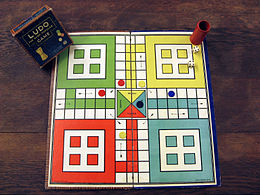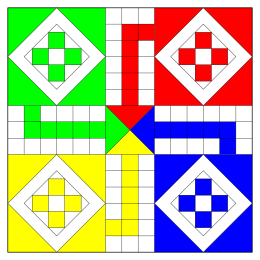Ludo (board game)

| |
| Years active | Since c. 1896 |
|---|---|
| Genre(s) | Board game Race game |
| Players | 2–4 |
| Age range | 4 and up[1] |
| Playing time | < 120 min |
| Random chance | Medium (dice rolling) |
| Skill(s) required | Strategy, tactics, counting,probability |
Ludo /ˈluːdoʊ/, /ˈljuː-/ (from Latin ludo, "I play") is a board game for two to four[2] players, in which the players race their four tokens from start to finish according to die rolls. Like other cross and circle games, Ludo is derived from the Indian game Pachisi, but simpler. The game and its variants are popular in many countries and under various names.
History[edit]
Pachisi originated in India by the 6th century.[3] The earliest evidence of this game in India is the depiction of boards on the caves ofAjanta.[3]
This game was played by the Mughal emperors of India; a notable example being that of Akbar.
Variations of the game made it to England during the late 19th century. One which appeared around 1896 under the name of Ludo was then successfully patented.[3]
Nomenclature[edit]
In North America, the game is sold under the brand name Parcheesi. Variations of the game are sold under the brand names Sorry!, Aggravation, and Trouble.
In Germany, this game is called "Mensch ärgere dich nicht" which means "Man, don't get irritated", and has equivalent names in Dutch, Croatian, Serbian, Bulgarian, Russian, Slovak, Slovene, and Polish, where it is more commonly referred to as Chińczyk ("The Chine(s)e").
In Greece, this game is called "Γκρινιάρης" [Griniaris] ("Grumbler") referring to typical player behaviour.
In Bulgaria, this game is known as "Не се сърди човече" [Ne se sardi choveche] ("Don't be angry, man").
In Czech, it's called "Člověče, nezlob se" ("Don't be angry, man").
In Vietnam, it is called "Cờ cá ngựa".
In Sweden it is known as "Fia", a name derived from the Latin word fiat which means "so be it!" Common variations on the name are "Fia-spel" (Fia the game) and "Fia med knuff" (Fia with push). In Denmark and Norway though, the game is known as Ludo.
Ludo board[edit]
Special areas of the Ludo board are typically coloured bright yellow, green, red, and blue. Each player is assigned a colour and has four tokens of matching colour (originally bone discs but today often made of cardboard or plastic). The board is normally square with a cross-shaped game track, with each arm of the cross consisting of three columns of squares—usually six squares per column. The middle columns usually have five squares coloured, and these represent a player's home column. A sixth coloured square not on the home column is a player's starting square. At the centre of the board is a large finishing square often composed of triangles in the four colours atop the players' home columns – thus forming "arrows" pointing to the finish.
Rules[edit]
Overview[edit]
Two, three, or four may play. At the beginning of the game, each player's tokens are out of play and staged in one of the large corner areas of the board in the player's color (called the player's yard ). When able to, the players will enter their tokens one per time on their respective starting squares, and proceed to race them clockwise around the board along the game track (the path of squares not part of any player's home column). When reaching the square below the home column, a player continues by racing tokens up the column to the finish square. The rolls of a cube die control the swiftness of the tokens, and entry to the finish square requires a precise roll from the player. The first to bring all their tokens to the finish wins the game. The others often continue play to determine second-, third-, and fourth-place finishers.
Rolls of the die[edit]
Each player rolls the die, the highest roller begins the game. The players alternate turns in a clockwise direction.
To enter a token into active play from his staging area to his starting square, a player must roll a 6. If the player has no tokens yet in play and does not roll a 6, the turn passes to the next player. Once a player has one or more tokens in play, he selects a token and moves it forward along the track the number of squares indicated by the die roll. If a player rolls a 6 he may choose to advance a token already in play, or alternatively, he may enter another of his tokens into active play. The rolling of a 6 earns the player an additional ("bonus") roll in that turn. If the additional roll results in a 6 again, the player earns an additional bonus roll. If the third roll is also a 6, the player may not move a token and the turn immediately passes to the next player. Players must always move a token according to the die value rolled, and if no move is possible, pass their turn to the next.
A player may not end his move on a square he already occupies. If the advance of a token finishes on a square occupied by anopponent's token, the opponent token is returned to its owner's yard. The returned token may only be reentered into play when the owner again rolls a 6. (Unlike Pachisi, there are no "safe" squares on the game track which protect a player's tokens from being returned. A player's home column squares are always safe, however, since no opponent may enter them. Ludo played in the Indian subcontinent features a safe square in each quadrant, normally the fourth square from the top in the rightmost column. These squares are usually marked with a star.)
Variations[edit]
- To get a game started faster, some house rules allow a player with no pieces on the board to bring their first piece into play on any roll, on a 1 or a 6, or allow multiple tries to roll a 6 (with three rolls being the most popular).
- If a piece lands on the same space as the another piece of the same colour, the moved piece must take the preceding space.
- If a player's piece lands on another of their own pieces, they are doubled and form a "block" which cannot be passed by any opponent's pieces. Or in some variations may only be passed by rolling a 6 or 1.
- Doubled pieces may move half the number if an even number is thrown (e.g. move two spaces if a 4 is thrown).
- A doubled piece may capture another doubled piece (like in Coppit).
- A board may have only four spaces in each "home column". All four of a player's pieces must finish in these spaces for the player to have finished the game. (See Mensch ärgere dich nicht.)
- To speed the game up, extra turns or bonus moves can be awarded capturing a piece or getting a piece home; these may grant passage past a block.
- In Denmark and some other countries the board has eight spaces marked with a globe and eight with a star. The globes are safe spaces where a piece cannot be captured. The exception is that a player who has not yet entered all pieces, can always enter a piece on a roll of 6. If the entry space is occupied by another player's piece, that piece is captured. Otherwise the entry spaces work like the other globe spaces. A piece which would have landed on a star instead moves to the next star.
In some parts of Africa the following rules are reportedly played:
- A doubled block also blocks trailing pieces of the player who created the block, or blocks them unless they roll the exact number to land on the block; additionally, the doubled block cannot move forward until the block that landed upon it moves off again. This reduces the tactical advantage of a block and makes the game more interesting.
- If the two players sitting opposite are partners, the players can exchange numbers.
- There are four safety squares on the board, like castle squares in Pachisi, as well as the safe home squares, where a piece may able to move forwards or backwards and start their turn before previous player finishes.
- A piece landing on a square with an opponent's piece not only sends the opponent piece back to the starting area but also sends the landing piece to its home square.
- A player cannot move their first piece into the "home column" unless they have captured at least one piece of any of the opponents.



No comments:
Post a Comment
Jayant Parkash Is Welcome All world to my blog